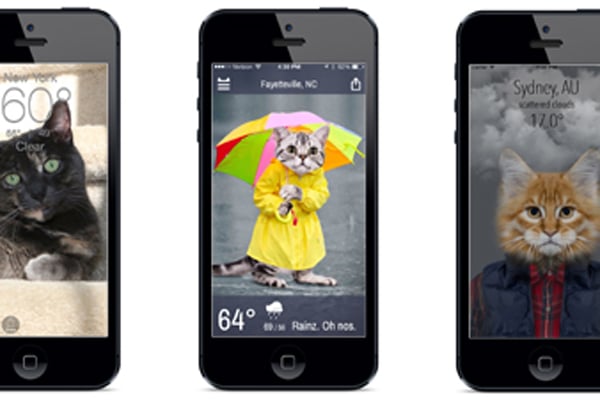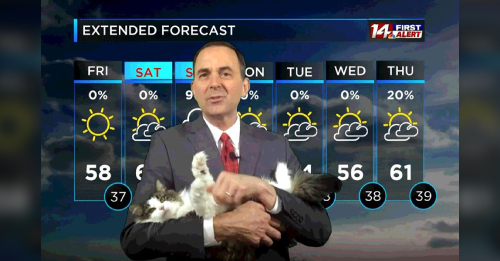
- #Feline weathercat how to#
- #Feline weathercat install#
- #Feline weathercat drivers#
- #Feline weathercat skin#
- #Feline weathercat registration#
Ask us if you need help deciding what and how much to feed your pet. Consider increasing their calorie allotment during the colder months.

Feed your frosty feline on a regular and predictable basis.
Supplying adequate food: A cold cat needs far more calories to keep warm. Insulate with something like straw and avoid electric heaters, which can be fire hazards. A wind and weather-proofed shelter off the ground can really help keep kitty warm. If your cat is outdoor-only, consider building a shelter where they can warm up. When the weather turns particularly nasty, do your best to bring them in. Providing a safe and reliable shelter: Indoor/outdoor cats should always have the option to come indoors. Do everything you can to help them, including: Keeping your cat warm and safe during the winter is possible, even if they insist on spending time outdoors. Keeping Your Cat Warm at Night and Safe Through the Winter So what is a cat lover to do? Keeping your cat inside is often the best answer, but not always well-received by the independent feline who has different ideas. Slippery or sharp surfaces that can lead to cuts and injuries. #Feline weathercat skin#
Rock salt and ice melt that can be toxic if ingested and irritating to skin and paws. Car engines and other warm but hazardous refuges. Plummeting temperatures leading to hypothermia or frostbite. Antifreeze ingestion causing serious toxicity. Half the battle is being prepared, and having a good grasp about what winter specific worries you should have for your cat is key. Hazards to Outdoor Cat Safety in the Winter 
#Feline weathercat how to#
But what about your pets? How to keep your cat warm in the winter months is an important consideration, especially if they venture outside. Use common sense and your past experience when migrating WeatherCat.It’s winter on the East Coast, and likely you are thinking of ways to ensure that you stay cozy and warm. However, most WeatherCat users customize their setups so that additional files may be necessary on the target computer than what has been listed here. This should be sufficient to allow you to move your WeatherCat installation from one computer to another. Be prepared to enter this information again on the new computer.
#Feline weathercat registration#
Keep in mind this process cannot transfer either your registration key for your copy of WeatherCat or anything stored on your OS X keychain like passwords for FTP and electronic mail servers. Otherwise, the Network settings on the iOS app will not be able to find your new computer. If you have been using the iOS WeatherCat app, remember to assign an internal static IP address (DHCP Reservation) to your new computer and forward the WeatherCat ports to the new IP address. Usually this means moving a folder with a name like: WC Custom Web Templates and a corresponding folder that by default is called: WeatherCatCustomWeb The default location for WeatherCatCustomWeb is ~/Library/Application Support, but since you can set these locations for your computer, you must move these folder to the same location as where you had decided to place them on the source computer for the target computer's installation to work properly. Move the files associated with your custom website if you have one running. If you are a Davis weather station user and have needed to use Davis's own WeatherLink software to make adjustments to your console or Weather Envoy, then you should copy the WeatherLink software also to your target computer. If you are using any integration software (for example WeatherCat AppleScripts) you must copy them from your source to target computer and place them in the same directory structure as you have on your source computer. Not all of these folders may be present depending on your WeatherCat configuration. ~/Library/Application Support/WeatherCatUpdate. ~/Library/Application Support/WeatherCatTemp.  ~/Library/Application Support/WeatherCatMedia.
~/Library/Application Support/WeatherCatMedia. 
~/Library/Application Support/WeatherCatCustomWeb.Copy the following folders from the source computer to the target computer, placing them in exactly the same file location as on your source computer:.Another way to make this folder visible is to hold down the Option key while clicking on the Go menu in the Finder. You can make it visible again via the following terminal command: chflags nohidden ~/Library/. If you are running OS X 10.7 or later, the Library folder is hidden.
#Feline weathercat drivers#
Note: WMR200, WH1080/2080/3080 stations do not need drivers to work with WeatherCat.
#Feline weathercat install#
Also be sure to install the correct drivers for your station or USB to serial converter* on the new machine before running WeatherCat.Place a copy of the WeatherCat application folder in the target computer's Application folder.If you are upgrading your Macinitosh the OS-X you can use the migration assistant that comes with OS-X to do this for you automatically. There are times when it is necessary to relocate your WeatherCat installation from one computer to another.








 0 kommentar(er)
0 kommentar(er)
